Berkeley’s Economics 1 (ECON 1 001) is a popular HASS replacement for SUTD students on exchange at Berkeley, alongside General Psychology (W1). Part of the appeal is because most concepts in ECON 1 001 are very similar to those in the A-Level, and the syllabus has a manageable depth. There aren’t any striking differences or difficulties; regardless, here’s a guide to ECON 1 001.
The 8-week module covers both Microeconomics and Macroeconomics, each spanning roughly 4 weeks. Familiar topics such as Opportunity Cost, Demand and Supply, Market Structures and Failures, Aggregate Demand and Supply, Monetary and Fiscal Policies, etc. all make their appearances in this module, which makes the scope quite wide and the module fast-paced. It helps if you’ve taken Economics before, but depending on when you last touched the subject, ECON 1 001 might feel like new to you. I recommend that you get a reference book, either from Popular or from Berkeley’s bookstores, to help you consolidate your concepts and better prepare yourself for homework and exams.
The weekly schedule consists of 2 lectures on Monday and Wednesday, and 2 discussion sessions (called “sections” at Berkeley). The lectures are largely the same as SUTD’s lectures, except for the fact that the lecture notes available online are incomplete and only filled up during the lecture, so skip them at your own risk (or just don’t). On the other hand, the discussion sessions are for the TAs and students to revisit lecture materials, complete workouts, give presentations and discuss difficult/ambiguous questions that may arise in the exams. All in all, they don’t feel different from SUTD’s environment.
Here’s the lecture hall during an Economics 1 lecture. The biggest difference from SUTD is probably the color theme of the hall’s interior.

There’re 3 main components in your ECON 1 001 grade: problem sets, class participation, and exams.
There’re 4 problem sets over 8 weeks, so a new set is due every 2 weeks. The problem sets provide you with medium-length questions that train you in reading charts and data, drawing graphs, doing arithmetic calculations, and most importantly reasoning and predicting using the economic framework. All 4 sets together are worth about a quarter of your grade.
Class participation is graded based on your attendance rate, how constructive you are in class (or if you’re quiet and not very social, how constructive and helpful you are on Piazza), and how good your class presentation is. Each student must give a presentation (solo or paired) analyzing a recent news article using economic concepts from the latest lectures. Class participation is worth 10% of your total grade.
There’re 2 exams: a Midterm and a Final. The Midterm places heavier emphasis on Microeconomics, while the Final focuses more on Macroeconomics. Both are long, about 80 minutes (though nowhere near as long as A-Level papers). You’re faced with roughly the same type of problems in your problem sets, so practicing using problem sets and past papers always pay dividends. Some questions may also be related to real-life scenarios mentioned in the lectures or the required reading, so it helps to read more if you can. The Midterm is worth about a quarter of your total grade, while the Final is worth over a third.
ECON 1 001 isn’t very easy to score high A’s on, because the grading is curved and most people max out their problem set and participation grades. However, it’s also pretty hard to score badly, making it a manageable credit transfer option especially if you’re taking another module alongside it. If you want to understand the process of decision-making and the economy in greater depth (or if you’re an ESD student), this module might be for you.






























